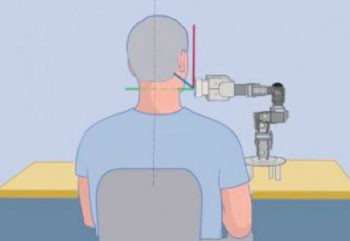Telerobotic Approach Provides Virtual Ultrasound Evaluations for Physicians, Hospitals, and Communities
By MedImaging International staff writers
Posted on 26 Aug 2014
An American physician, while in Germany, used a computer to perform a robot-assisted transatlantic ultrasound exam on a person in Boston (MA, USA). In another study, a Swedish doctor, working in collaboration with another physician, showed how a cardiologist’s video e-consultation, combined with a remote robot-assisted echocardiogram test, can drastically lessen the waiting time for a diagnosis faced by heart failure patients who live in a rural communities far from the hospital from nearly four months to less than one month. Posted on 26 Aug 2014
These research studies were published in the August 2014 issue of the Journal of the American College of Cardiology-Imaging. “The two studies give us a glimpse of what to expect in the near future, a patient-friendly imaging technology at your doorstep,” said Jagat Narula, MD, PhD, senior author of both research studies who serves as the director of the Mount Sinai Cardiovascular Imaging Center and associate dean of global research at Icahn School of Medicine at Mount Sinai (New York, NY, USA).
“These studies lift the robotic imaging and telemedicine to the next level,” remarked Sherif F. Nagueh, MD, medical director of the echocardiography laboratory at the Methodist DeBakey Heart and Vascular Center (Houston, TX, USA), who authored the accompanying editorial about the two studies in JACC-Imaging.
“Our first-in-man experiment shows long-distance, telerobotic ultrasound examinations over standard internet are possible,” said Partho P. Sengupta, MD, who is director of cardiac ultrasound research at Icahn School of Medicine at Mount Sinai, and chair of the new technology Task Force at the American Society of Echocardiography. “Our successful experiment opens up a new frontier for the use of remote, robotic ultrasound imaging that could potentially be more efficient and cost-effective overall for healthcare access and delivery.”
In the first study, lead investigator Dr. Sengupta and researchers assessed the use of a small, lightweight robotic-arm with built-in ultrasound technology located in Boston and connected to a personal computer (PC) with a low-bandwidth Internet connection in Munich, Germany. The robotic ultrasound exam of an individual’s carotid artery in their neck was completed in just four minutes.
“This feasibility and time-efficiency of long-distance, telerobotic ultrasound may help expand the role of imagers to care for patients online virtually lending a true ‘helping hand’ remotely and providing a patient’s care team expert guidance,” said Mount Sinai’s Dr. Sengupta. Significantly, in the study experiments, both advanced specialists and early trainees on robotic ultrasound were able to operate the telerobotic technology.
In the second study, Kurt Boman, MD, of Umea University (Umea, Sweden) and colleagues randomized half their study patients to remote consultation and the other half to standard of care referral to the hospital. Remote consultation and the robotic echocardiogram exam were conducted on the same day of a patient’s visit to their local Primary healthcare center located more than 100 miles away from the hospital. Study results show, the total diagnostic process time was greatly decreased from 114 to 27 days in those patients receiving remote consultation. Furthermore, the patient’s wait time until obtaining a specialist consultation was reduced from 86 to 12 days, with 95% of remote consult patients claiming remote consult to be a superior strategy.
“As a result of our pilot study, we were able to establish a safe and efficient e-health solution to improve the comprehensive, convenient examination of suspected heart failure patients in a rural community of northern Sweden and improve their physician care team's communication,” stated Dr. Narula of Mount Sinai. “This pilot study may serve as a future model for use of e-consults and robotic imaging in similar rural communities to improve access to specialists and the latest diagnostic technology globally.”
“In clinical medicine, the use of more portable low-cost, safe, non-radiation using ultrasound imaging technology is growing for diagnosis, patient monitoring, and procedural, and surgical planning,” commented Valentin Fuster, MD, PhD, director of Mount Sinai Heart at Icahn School of Medicine at Mount Sinai and the new editor-in-chief of the Journal of the American College of Cardiology (JACC). “The technology may be key to accelerating greater local and global healthcare access more efficiently and cost-effectively for patients, doctors, communities, and hospitals in need.”
According to researchers, on-demand, virtual robotic ultrasound could be used in a wide variety of clinical setting collaborations ranging from in-hospital or emergency room patient imaging studies, community screenings, or even within hazardous sites such as war zones.
Related Links:
Icahn School of Medicine at Mount Sinai
Umea University
















